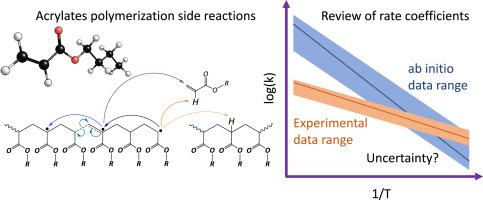Our official English website, www.x-mol.net, welcomes your feedback! (Note: you will need to create a separate account there.)
Secondary reactions during acrylate radical polymerization: Determining their rate coefficients
Polymer ( IF 4.6 ) Pub Date : 2024-03-22 , DOI: 10.1016/j.polymer.2024.126938 Fernando A. Lugo , Mariya Edeleva , Paul H.M. Van Steenberge , Maarten K. Sabbe
Polymer ( IF 4.6 ) Pub Date : 2024-03-22 , DOI: 10.1016/j.polymer.2024.126938 Fernando A. Lugo , Mariya Edeleva , Paul H.M. Van Steenberge , Maarten K. Sabbe

|
Secondary reactions in the radical polymerization of acrylic monomers are challenging to include in the existing kinetic models. It is laborious to experimentally measure their rate coefficients as they occur in parallel to the main reactions, but with a much smaller rate. However, secondary reactions contribute to the formation of specific functional groups in polymer molecules, unsaturation, branching, ., influencing the molecular and material properties of the polymers. Therefore, it is important to correctly account for them in the computer models/digital twins of the polymerization processes to correctly predict the polymer structures. Because of the large uncertainties on secondary rate coefficients, this work provides a systematic review of the experimental measurements and theoretical predictions of the secondary reactions’ rate coefficients, accounting for mid-chain radical propagation, backbiting, beta-scission, chain transfer to polymer, and monomer and macromonomer propagation. Special attention is devoted to the measurement techniques, outlining the accuracy and limitations of each method. For the theoretical calculations, we focus on the Arrhenius parameters predictions and try to make fairer comparisons with experiments.
中文翻译:

丙烯酸酯自由基聚合过程中的副反应:确定其速率系数
丙烯酸单体自由基聚合中的副反应很难纳入现有的动力学模型中。通过实验测量它们的速率系数很困难,因为它们与主要反应平行发生,但速率要小得多。然而,副反应有助于在聚合物分子中形成特定官能团、不饱和度、支化等,从而影响聚合物的分子和材料性能。因此,在聚合过程的计算机模型/数字孪生中正确解释它们以正确预测聚合物结构非常重要。由于二次反应速率系数存在很大的不确定性,这项工作对二次反应速率系数的实验测量和理论预测进行了系统回顾,解释了中链自由基传播、背咬、β-断裂、链转移到聚合物、以及单体和大分子单体的增长。特别关注测量技术,概述每种方法的准确性和局限性。对于理论计算,我们重点关注阿伦尼乌斯参数预测,并尝试与实验进行更公平的比较。
更新日期:2024-03-22
中文翻译:

丙烯酸酯自由基聚合过程中的副反应:确定其速率系数
丙烯酸单体自由基聚合中的副反应很难纳入现有的动力学模型中。通过实验测量它们的速率系数很困难,因为它们与主要反应平行发生,但速率要小得多。然而,副反应有助于在聚合物分子中形成特定官能团、不饱和度、支化等,从而影响聚合物的分子和材料性能。因此,在聚合过程的计算机模型/数字孪生中正确解释它们以正确预测聚合物结构非常重要。由于二次反应速率系数存在很大的不确定性,这项工作对二次反应速率系数的实验测量和理论预测进行了系统回顾,解释了中链自由基传播、背咬、β-断裂、链转移到聚合物、以及单体和大分子单体的增长。特别关注测量技术,概述每种方法的准确性和局限性。对于理论计算,我们重点关注阿伦尼乌斯参数预测,并尝试与实验进行更公平的比较。



























 京公网安备 11010802027423号
京公网安备 11010802027423号